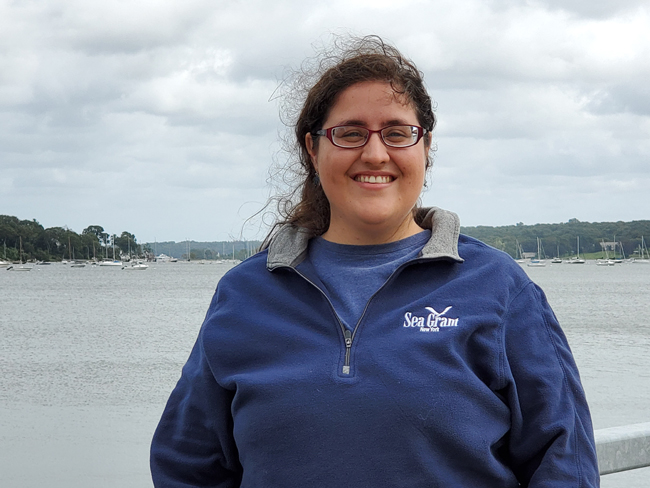Published for Stony Brook University's E-news Site, Happenings
Stony Brook, NY, December 18, 2019 - New York Sea Grant (NYSG) has hired Jimena Perez-Viscasillas as its Long Island Sound Study (LISS) outreach coordinator. Based at Stony Brook University, her role is to provide science-based information about Long Island Sound to residents of New York.
As one of her first tasks, she assisted in this fall’s successful second annual Estuary Day, which focused on microplastics and marine debris education. Perez-Viscasillas will continue her career efforts to promote community engagement with natural resources by working to increase the appreciation, stewardship, awareness and understanding of Long Island Sound and the projects to restore and protect it. She will create educational programs designed to help people protect the Long Island Sound resource.

Jimena Perez-Viscasillas. Credit: Rebecca Shuford / NYSG.
As an undergraduate, Perez-Viscasillas earned a BS in Biology from the University of Puerto Rico – Mayaguez (UPRM). Initially interested in genetics and marine science, she worked in the UPRM Marine Genomic Biodiversity Laboratory for three years. Wanting to pursue her interest in aquatic sciences, but with a larger emphasis on applied environmental conservation, Perez-Viscasillas then attended Duke University’s Nicholas School of the Environment, where she earned a master’s in Environmental Management; Ecosystem Science and Conservation Concentration and a certificate in Community-Based Environmental Management.
As a graduate student, Perez-Viscasillas gained a breadth and depth of experience providing effective outreach to and engaging with natural resource communities, including co-authoring the paper, “Exploring the Potential Influence of Citizen Science Water Monitoring Programs on Water Resources Management and Policy in the Global South.” She also served as a Stanback Fellow in the Center for the Environment at Catawba College, where she assisted in communications, survey-design research, and planning the annual Redesigning Our Future Youth Environmental Summit.
While working as a student fellow at the Duke Superfund Community Engagement Core, Perez-Viscasillas partnered with town officials to provide environmental health information to a local community. She also contributed to the development of a social marketing campaign targeting fish consumption behavior in North Carolina.
“That’s where I discovered social marketing, and where I learned I really love working directly with stakeholders,” Perez-Viscasillas said.
All of Perez-Viscasillas’ educational experiences helped shape her love for communicating science and passion for working with natural resource communities and providing thoughtful and effective outreach to take care of those resources.
“During my master’s program, my focus became connecting people to their environment, regardless of the ecosystem. I am thrilled to work for Sea Grant and the Long Island Sound Study because it allows me to continue to interact with natural resource communities and takes me back to the marine sciences, which, coming from Puerto Rico, has always had a very special place in my heart,” she said.
The Long Island Sound Study, conducted under the Environmental Protection Agency’s (EPA) National Estuary Program, is a cooperative effort between the EPA and the states of Connecticut and New York to restore and protect the Sound and its ecosystems.
Learn more about Long Island Sound stewardship and how you can get involved.
More Info: Long Island Sound Study
Long Island Sound is one of the 28 nationally-designated estuaries under
the NEP, which was established by Congress in 1987 to improve the
quality of Long Island Sound and other places where rivers meet the sea.
The Long Island Sound Study, conducted under the Environmental
Protection Agency’s (EPA) National Estuary Program (NEP), is a
cooperative effort between the EPA and the states of Connecticut and New
York to restore and protect the Sound and its ecosystems.
For more on what you can do to make a difference, click over to the "Get Involved" or "Stewardship" sections of the Long Island Sound Study's Web site. News on the Long Island Sound Study can also be found in New York Sea Grant's related archives.
If you would like to receive Long Island Sound Study's newsletter, please visit their site's homepage and sign up for the "e-news/print newsletter" under the "Stay Connected" box.
For daily updates and tips on how you can help protect and restore Long Island Sound, please join LISS on Facebook, Twitter or, sign up for their RSS feeds.
More Info: New York Sea Grant
New York Sea Grant (NYSG), a cooperative program of Cornell University
and the State University of New York (SUNY), is one of 34 university-based
programs under the National Oceanic and Atmospheric Administration’s
National Sea Grant College Program.
Since 1971, NYSG has represented a statewide network of integrated
research, education and extension services promoting coastal community
economic vitality, environmental sustainability and citizen awareness
and understanding about the State’s marine and Great Lakes resources.
Through NYSG’s efforts, the combined talents of university scientists
and extension specialists help develop and transfer science-based
information to many coastal user groups—businesses and industries,
federal, state and local government decision-makers and agency managers,
educators, the media and the interested public.
The program maintains Great Lakes offices at Cornell University, SUNY
Buffalo, SUNY Oswego and the Wayne County Cooperative Extension office
in Newark. In the State's marine waters, NYSG has offices at Stony Brook
University in Long Island, Brooklyn College and Cornell Cooperative
Extension in NYC and Kingston in the Hudson Valley.
For updates on Sea Grant activities: www.nyseagrant.org has RSS, Facebook, Twitter, and YouTube links. NYSG offers a free e-list sign up via www.nyseagrant.org/nycoastlines for its flagship publication, NY Coastlines/Currents, which is published quarterly. Our program also produces an occasional e-newsletter,"NOAA Sea Grant's Social Media Review," via its blog, www.nyseagrant.org/blog.